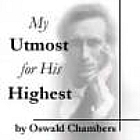 The Everlasting Man, G. K. Chesterton
The Everlasting Man, G. K. ChestertonConsidered by many to be Chesterton's best work, I had high expectations for this book. Some of those expectations it met, some of them it didn't. Chesterton is, beyond doubt, a master with words. There are many passages that are difficult to match for sheer beauty of expression. That said, the prospective reader should be warned that the writing is somewhat denser than, say, that of Lewis; it doesn't exactly whisk you along. But the hardest roads often deliver the grandest vistas, and the attentive and diligent will be rewarded. Enough about the writing: perhaps I should tell you about the book.
Starting out, dealing with the origins both of civilisation and man himself, Chesterton presents a masterful, philosophical critique of evolutionary theory. "It is the simple truth that man does differ from the brutes in kind and not in degree; and the proof of it is here; that it sounds like a truism to say that the most primitive man drew a picture of a monkey and that it sounds like a joke to say that the most intelligent monkey drew a picture of a man. Something of division and disproportion has appeared; and it is unique. Art is the signature of man." (Pg. 34, Ch. I, The Man In The Cave) Here he delineates a crisp distinction in the matter of art, and again in the matter of spirituality: "It is of little use here to compare the head of the man with the head of the monkey, if it certainly never came into the head of the monkey to bury another monkey with nuts in his grave to help him towards a heavenly monkey-house." (Pg. 274, Appendix I, On Prehistoric Man)
From here, he goes on to examine the philosophical - not historical - development of civilisation. After defining and dealing with mythology at length, he establishes the uniqueness of the Christian God and prepares to introduce the story of Jesus, which, as told, is the most uncommon presentation of the gospel that I have ever heard; it is refreshing. Sometimes the old, old story needs to be dusted off a little. (Chesterton said as much in the introduction: "In the specially Christian case we have to react against the heavy bias of fatigue. It is almost impossible to make the facts vivid, because the facts are familiar; and for fallen men it is often true that familiarity is fatigue." (Pg. 17)) Consequently, it is worth reading the book for that chapter alone, ("The Strangest Story In The World,") which ends with what is very likely the most beautiful paragraph describing the resurrection ever written. "On the third day the friends of Christ coming at day-break to the place found the grave empty and the stone rolled away. In varying ways they realised the new wonder; but even they hardly realised that the world had died in the night. What they were looking at was the first day of a new creation, with a new heaven and a new earth; and in a semblance of a gardener God walked again in the garden, in the cool not of the evening but the dawn." (Pg. 213)
 Heroes And Herectics, Barrows Dunham
Heroes And Herectics, Barrows DunhamIf Chesterton was Solomon, Dunham must certainly be Rehoboam. The writing is similarly weighty, and also somewhat drier, or at least more concrete; names and places and dates abound. It requires a broader literary base than I possess to grasp the full import of what these authors have to say, as they are forever referencing man and myth and metaphor to illustrate their ideas; Dunham writes about Ancient Greece as if he has been there.
The premise of the book centers around the twin but distinct questions of heresy vs. orthodoxy and truth vs. error. "The question whether a sentence is true or false is a question in science, in logic, and in philosophy. But the question whether a sentence is orthodox or heretical is an organizational question... The sentences in [an] ideology are the ones that are there, whether they are true or not. Truth-falsity and orthodoxy-heresy are thus two different questions." (Pgs. 18-19, Ch. I, Man and Membership) Working off this idea, Dunham traces both threads through history for the bulk of the book, observing where they (in his view) marry and where they diverge.
It took me a long time to figure out where Dunham was coming from. Although there are numerous clues, it's not until the end of the book that you realize he is a full-fledged advocate of Darwinism, Socialism, and extreme Humanism. His appraisal of Christianity is weak, and his view of Jesus is careless and confused. (He portrays Jesus as a politically-minded social revolutionary, and believes that Paul espoused separate ideals.) In his Bibliographical Essay, Dunham notes that "The life of Jesus, the Bible, and the problems relating to both, ... are matters of much ... difficulty. A vast literature surrounds all these, such as only a scholar devoted to the subject can adequately know. I confess at once a limited acquaintance. My belief that the historical Jesus was leader of an insurrectionary movement comes directly from Archibald Robertson's The Origins of Christianity..." (Pg. 477) On this basis, it seems fair to dismiss Dunham as a scripturally-grounded authority; he essentially dismisses himself.
On a positive note, Dunham shows himself to be a firm proponent of freedom of conscience. "Coercion... cannot make a man hold 'good opinions' in the way in which good opinions ought to be held, by simple awareness of their truth and value." (Pg. 22, Ch. 1, Man and Membership) Remnant-minded Christians will resonate with His distaste for Geneva, the Inquisition, and other such institutions. It is unlikely that I will reread this book, but I will probably reference it occasionally. Highlighters are great.
 Annapurna, Maurice Herzog
Annapurna, Maurice HerzogThe runt of the litter, this mountaineering chronicle from the 1950's documents the first successful climb of an 8,000 meter mountain: Annapurna, Nepal, by a French expedition. Written by the expedition leader who was also one of the two men to summit, the book abounds in cheap sentiments and nostalgia. Notwithstanding, it remains classic mountaineering literature (I'm not exactly sure why). If you're not into mountains, don't bother; if you are, use plenty of salt.
The expedition itself lacked seriousness; it seemed half-witted and haphazard. The poor planning became evident in the frightful, badly-timed descent. Herzog paid for it, losing most of his fingers and toes to frostbite and suppurating all over India on the return trip.
This is my third mountaineering book, (behind Teewinot by Jack Turner and Into Thin Air by Jon Krakauer.) I don't think I'll read any more. They make me sick.
 On Writing Well, William Zinsser
On Writing Well, William ZinsserI love reading books on writing because they are always written so precisely. Good writers know what they are doing and they do it well.
This little volume is no exception - guaranteed to make you chuckle, think, and (Oh my, I almost forgot!) write better to boot. Zinsser makes no effort to hide the zeal he has for his craft, and, as is typical of a healthy zealot, he occasionally flares up in righteous anger against vague, stuffy, insecure writing.
If you write, read it. If you don't write, you ought to.












No comments:
Post a Comment